Program Terra-3 - complex 5Н76
The proposals were based on the study of LPI of high-energy photodissociation lasers (FDL) on organic iodides and the proposal of VNIIEF about “pumping the FDL with a strong shock wave generated in an inert gas by an explosion.” The State Optical Institute (GOI) also joined the work. The program was named "Terra-3" and envisaged the creation of lasers with energies greater than 1 MJ, as well as the creation on their basis of the Balkhash test site of the 5H76 scientific-experimental laser complex (NEC), on which the ideas of the laser system for missile defense were to be tested in natural conditions. N.G. Basov has been appointed scientific director of the "Terra-3" program.
In 1969, from the Vympel Design Bureau, the team of the Specialized Design Bureau was distinguished, on the basis of which Luch (later Astrophysics) was formed, which was entrusted with the implementation of the Terra-3 program.
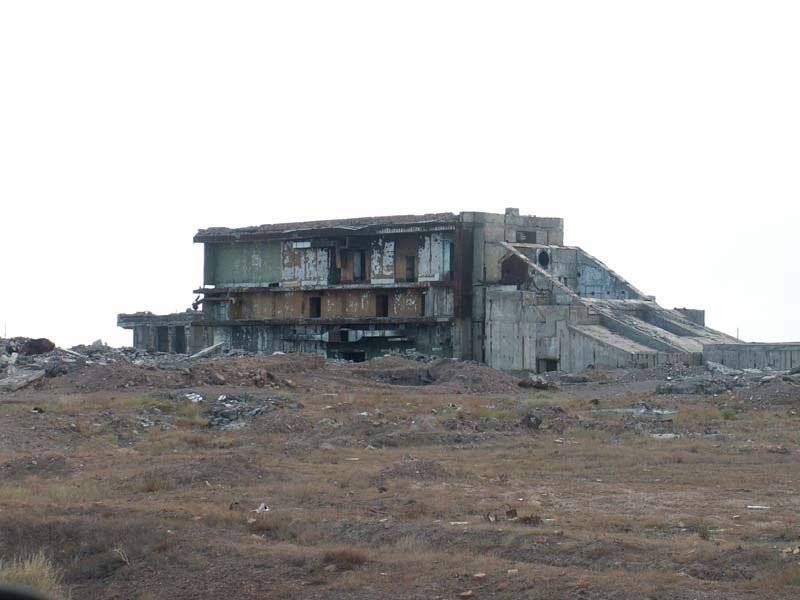
Remains of the 41 / 42В structure with the 5H27 laser locator complex of the Terra-5 76H3 shooting complex, photo 2008.
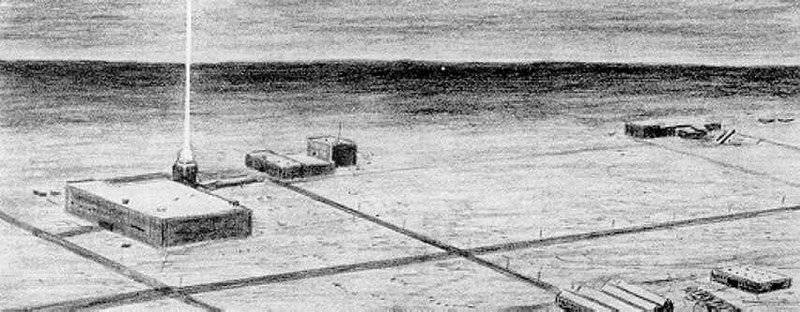
Scientific Experimental Complex "Terra-3" according to American ideas. In the US, it was believed that the complex was designed for anti-satellite purposes with a transition in the future to missile defense. The drawing was first introduced by the American delegation at the Geneva talks in 1978. View from the southeast.
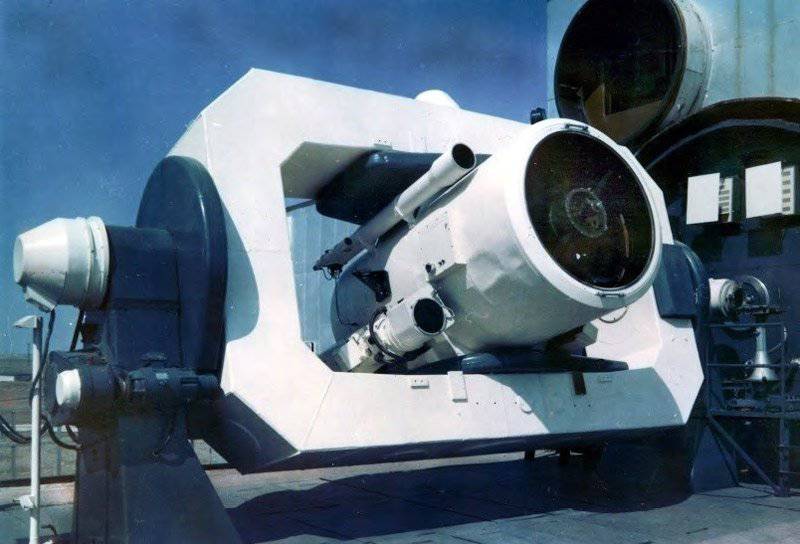
Telescope TG-1 laser locator LE-1, Sary-Shagan test site (Zarubin PV, Polskih SV From stories the creation of high-energy lasers and laser systems in the USSR. Presentation. 2011 g.).
The program "Terra 3" included:
- Fundamental research in the field of laser physics;
- The development of laser technology;
- Development and testing of “large” experimental laser “machines”;
- Studies of the interaction of high-power laser radiation with materials and the determination of the vulnerability of military equipment;
- Study of the propagation of high-power laser radiation in the atmosphere (theory and experiment);
- Research on laser optics and optical materials and the development of technology "power" optics;
- Works in the field of laser location;
- Development of methods and technologies of laser beam guidance;
- Creation and construction of new scientific, design, production and testing institutes and enterprises;
- Training of undergraduate and graduate students in the field of laser physics and technology.
The work on the Terra-3 program developed in two main directions: laser location (including the problem of target selection) and laser destruction of the ballistic missile warhead. The program was preceded by the following achievements: in 1961, the idea of creating photodissociation lasers (Rautian and Sobelman, FIAN) arose, and in 1962, studies of laser location were started at Vympel Design Bureau together with FIAN, and it was also proposed to use shock front radiation waves for laser optical pumping (Krokhin, LPI, 1962). In 1963, the Vympel Design Bureau began the development of the project of the LE-1 laser locator. After the start of work on the program "Terra-3" for several years passed the following steps:
- 1965, the experiments with high-energy photodissociation lasers (VFDL) started, the power of JNUMX J was reached (FIAN and VNIIEF);
- 1966 g. - pulse energy received in VFDL 100 J;
- 1967, the schematic diagram of the experimental laser locator LE-1 (Vympel Design Bureau, FIAN, GOI) was chosen;
- 1967 g. - pulse energy 20 KJ was obtained with VFDL;
- 1968 g. - pulse energy 300 KJ was obtained with VFDL;
- 1968 g. - work has begun on a program to study the effects of laser radiation on objects and material vulnerabilities, the program was completed in 1976 G .;
- 1968 g. - research and creation of HF, CO2, high energy CO lasers (FIAN, Luch - Astrophysics, VNIIEF, GOI, etc.) started; work completed in 1976 g.
- 1969 g. - pulse energy was obtained with VFDL around 1 MJ;
- 1969 g. - the development of the locator LE-1 is completed and the documentation is released;
- 1969 g. - the development of a photodissociation laser (FDL) has begun with pumping radiation from an electric discharge;
- 1972, the city - to conduct experimental work on lasers (outside the Terra-3 program), it was decided to establish an interdepartmental research center of the Raduga Design Bureau with a laser test site (later - Astrophysics Central Design Bureau).
- 1973 g. - started industrial production of VFDL - FO-21, F-1200, FO-32;
- 1973 g. - the installation of an experimental laser complex with the LE-1 locator started at the Sary-Shagan test site, the testing and testing of the LE-1 began;
- 1974 g. - created SRS adders of the AF series (LPI, “Luch” - “Astrophysics”);
- 1975 g. - created a powerful FDL with electric pumping, power - 90 KJ;
- 1976 g. - created 500 KW electroionization CO2 laser (“Luch” - “Astrophysics”, FIAN);
- 1978, the locator LE-1 was successfully tested, the tests were carried out on airplanes, ballistic warhead warheads and satellites;
- 1978, on the basis of the Central Design Bureau "Ray" and the IDC "Raduga" OKB was formed by the Astrophysics NPO (outside the Terra-3 program), the general director is I.Ptitsyn, the general designer is ND Ustinov ( son DF Ustinov).
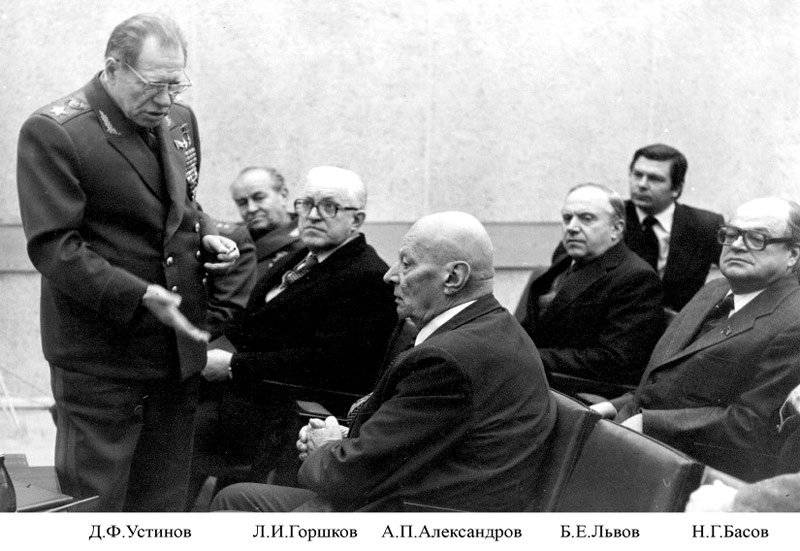
Visit of the Minister of Defense of the USSR DFUstinov and Academician APAleksandrov to the OKB "Rainbow", the end of the 1970-ies. (Zarubin P.V., Polskikh S.V. From the history of the creation of high-energy lasers and laser systems in the USSR. Presentation. 2011).
At FIAN, a new phenomenon was investigated in the field of nonlinear laser optics — the reversal of the radiation wavefront. This is a major discovery.
further allowed us to approach a number of problems in the physics and technology of high-power lasers, primarily the formation of an extremely narrow beam and its ultra-precise aiming at a completely new and very successful approach. For the first time, it was in the “Terra-3” program that the experts of VNIIEF and FIAN suggested using wavefront reversion for targeting and delivering energy to a target.
In 1994, N.G. Basov, answering the question about the results of the laser program “Terra-3”, said: “Well, we firmly established that no one can shoot down
BR warhead with a laser beam, and we have great lasers advanced ... “.
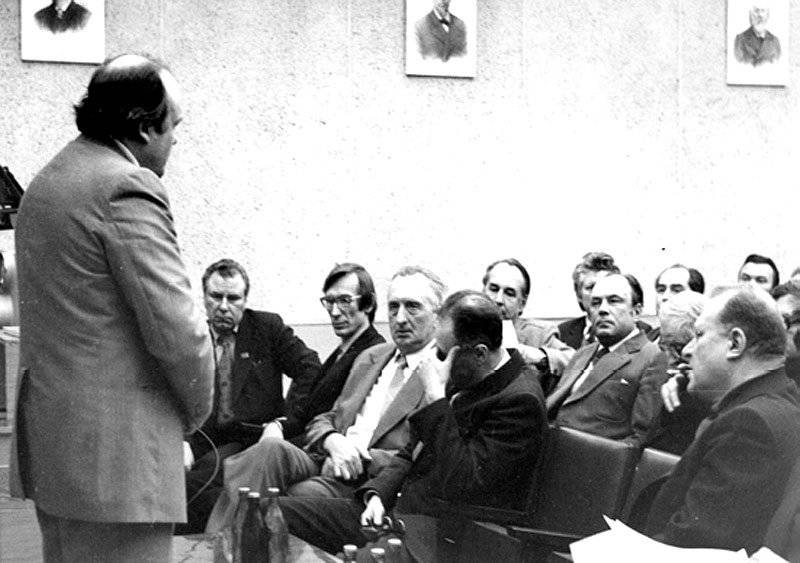
Academician E.Velikhov speaks at the scientific and technical council. In the first row in light gray AM Prokhorov - the scientific director of the program "Omega". End of 1970's. (Zarubin P.V., Polskikh S.V. From the history of the creation of high-energy lasers and laser systems in the USSR. Presentation. 2011).
Subroutines and directions of research "Terra-3":
Complex 5Н26 with laser locator ЛЭ-1 according to the program "Terra-3":
The potential of laser locators to ensure particularly high precision measurements of the target's position was studied at the Vimpel Design Bureau, starting with 1962. As a result of the Vympel Design Bureau, using the forecasts of the NG Basov group, research, at the beginning of 1963 in the Military -The Industrial Commission (MIC, the government body of the military-industrial complex of the USSR) presented a project to create an experimental laser locator for a missile defense system, which was conditionally named LE-1. The decision to set up an experimental installation at the Sary-Shagan test site with a range of up to 400 km was approved in September by 1963. In 1964-1965, The project was being developed at the Vympel Design Bureau (G.Ye. Tikhomirov laboratory). The design of the optical systems of the locator was carried out by the GOI (laboratory of P.P. Zakharov). Construction of the facility began in the late 1960-ies.
The project was based on the work of LPI on research and the creation of ruby lasers. The locator had to carry out in a short time the search for targets in the “error field” of the radars, which provided target designation to the laser locator, which required very high average laser emitter powers at that time. The final choice of the structure of the locator determined the real state of work on ruby lasers, the achievable parameters of which in practice turned out to be significantly lower than originally assumed: the average power of a single laser instead of the expected 1 KW was approximately 10 W in those years. Experiments conducted in the laboratory of N.G. Basov at FIAN showed that increasing the power by sequentially amplifying the laser signal in the chain (cascade) of laser amplifiers, as was initially envisaged, is possible only up to a certain level. Too powerful radiation destroyed the laser crystals themselves. There were also difficulties associated with thermo-optical distortions of radiation in crystals. In this connection, it was necessary to install not one 196 in the locator, but alternately 10 lasers operating at the 1 frequency of Hz J. The pulse energy of the multichannel laser transmitter of the locator was about 2 kW. This led to a significant complication of his scheme, which was multipath both in radiation and in signal registration. It was necessary to create high-precision, high-speed optical devices to form, switch, and direct 196 laser beams, which determined the search field in the target space. In the locator receiver, a matrix of 196 specially designed PMTs was used. The task was complicated by errors associated with large-sized mobile optical-mechanical systems of the telescope and optical-mechanical switches of the locator, as well as distortions introduced by the atmosphere. The total length of the optical path locator reached 70 m and it consisted of many hundreds of optical elements - lenses, mirrors and plates, including moving, mutual adjustment of which was to be maintained with the highest accuracy.
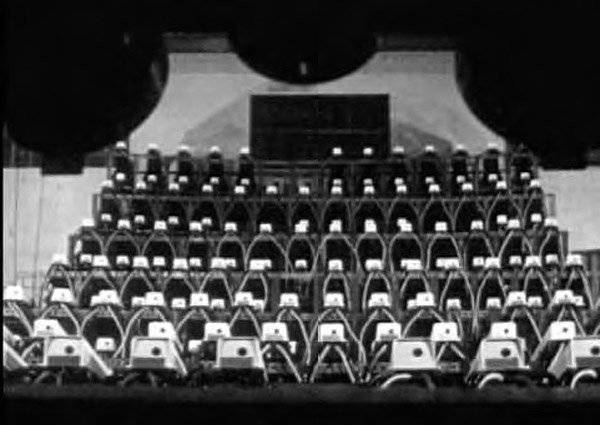
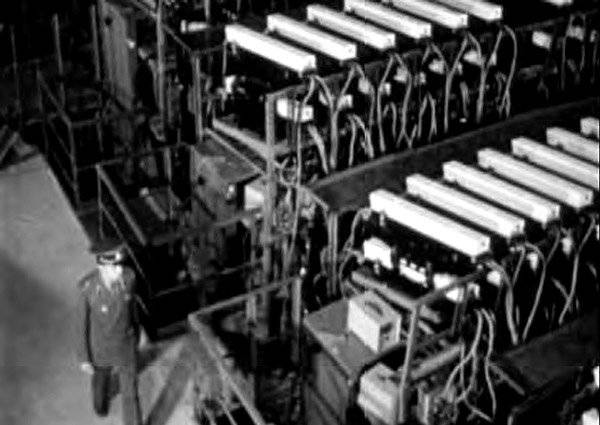
Transmitting lasers of the LE-1 locator, Sary-Shagan test site (Zarubin PV, Polskikh SV From the history of the creation of high-energy lasers and laser systems in the USSR. Presentation. 2011).
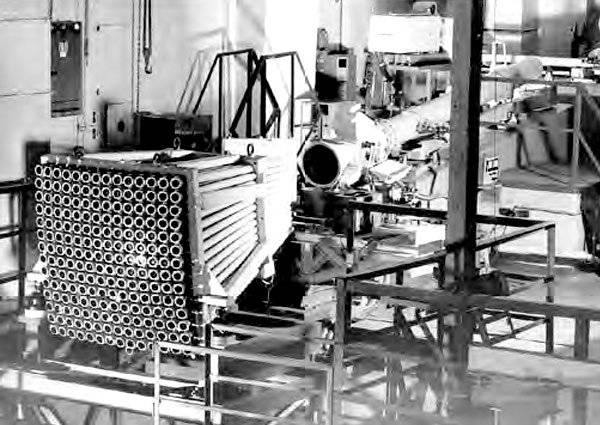
Part of the optical path of the laser locator LE-1, Sary-Shagan test site (Zarubin PV, Polskih SV From the history of the creation of high-energy lasers and laser systems in the USSR. Presentation. 2011).
In 1969, the project LE-1 was transferred to the Luch Central Design Bureau of the USSR Ministry of Defense Industry. N. D. Ustinov was appointed Chief Designer of LE-1. In 1970-1971. the development of the locator LE-1 was completed as a whole. The extensive cooperation of defense complex enterprises took part in the creation of the locator: LOMO and the Leningrad Bolshevik plant created the telescope TG-1 for LE-1, unique in terms of the set of parameters, the main designer of the telescope, B.K.Ionessian (LOMO). This telescope with a diameter of the main mirror 1.3 m provided a high optical quality of the laser beam when working with speeds and accelerations hundreds of times higher than that of the classic astronomical telescopes. Many new locator nodes were created: high-speed accurate scanning and switching systems for controlling the laser beam, photo detectors, electronic signal processing and synchronization units, and other devices. The control of the locator was automatic using computers, the locator was connected to the radar stations of the polygon using digital data transmission lines.
With the participation of the Geophysics Central Design Bureau (D.M. Khorol) a laser transmitter was developed, which included 196 highly advanced lasers for that time, their cooling and power supply systems. For LE-1, the production of high-quality ruby laser crystals, non-linear KDP crystals and many other elements was organized. In addition to N. D. Ustinov, the development of LE-1 was led by O. Ushakov, G. E. Tikhomirov and S. V. Bilibin.
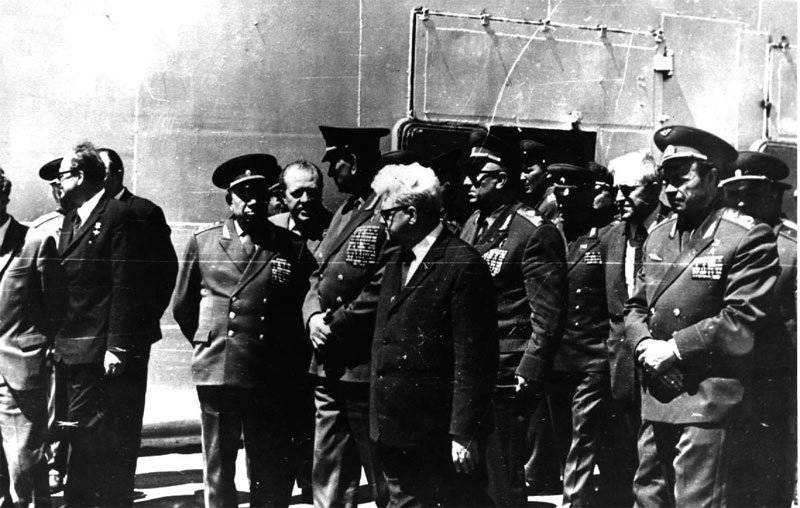
Heads of the USSR military-industrial complex at the Sary-Shagan test site, 1974. The center in glasses is USSR Minister of Defense Industry S.A. Zverev, to the left is Minister of Defense A.A. Grechko and his deputy Epishev, second from left is N.G. . Basov. (Polskikh SD, Goncharova G.V. SSC RF FGUP NPO Astrofizika. Presentation. 2009).
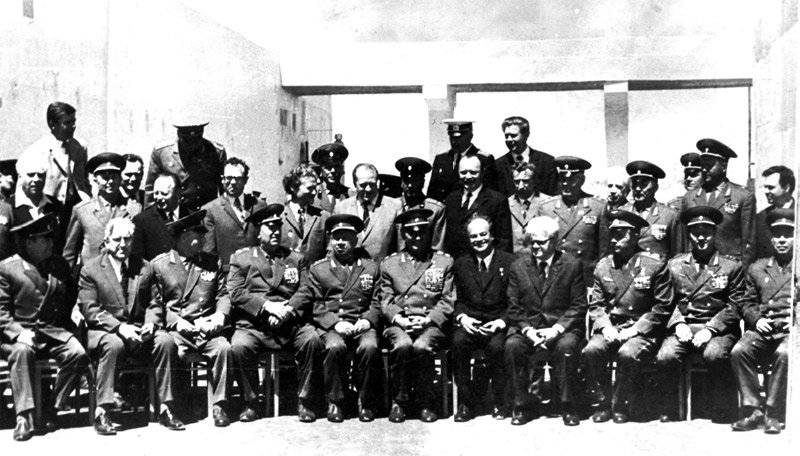
The leaders of the USSR military-industrial complex at the site of LE-1, 1974. Center in the first row - Minister of Defense A.A. Grechko, to his right - N.G. Basov, then - Minister of Defense Industry of the USSR S.A. Zverev . (Zarubin P.V., Polskikh S.V. From the history of the creation of high-energy lasers and laser systems in the USSR. Presentation. 2011).
Construction of the facility began in 1973. Commissioning work was completed in 1974, and testing of the facility began with the TG-1 telescope of the LE-1 locator. In 1975, during tests, a confident location of an aircraft type target was achieved at a distance of 100 km, work began on the location of the warheads of ballistic missiles and satellites. In 1978-1980. With the help of LE-1 high-precision trajectory measurements and wiring of rockets, warheads and space objects were carried out. In 1979, the laser locator LE-1 as a means for accurate trajectory measurements was adopted for joint technical maintenance of the 03080 military unit (GNIIP No. 10 of the USSR Ministry of Defense, Sary-Shagan). For the creation of the locator LE-1 in 1980, employees of the TsKB Luch were awarded the Lenin and State Prizes of the USSR. Active work on the locator LE-1, incl. with the modernization of the electronic circuits and other equipment, continued until the middle of the 1980-s. Work was carried out on obtaining non-coordinate information objects (information on the shape of objects, for example). October 10 1984. The 5Н26 / LE-1 laser locator measured the parameters of the target - the Challenger reusable spacecraft (USA) - for more details, see the Status section below.
TTX locator 5H26 / LE-1:
The number of lasers in the path - 196 pcs
Optical path length - 70 m
Installation capacity average - 2 kW
The range of the locator - 400 km (on the project)
Coordinate accuracy:
- by distance - no more than 10 m (for the project)
- on a corner of a place - several angular seconds (according to the project)
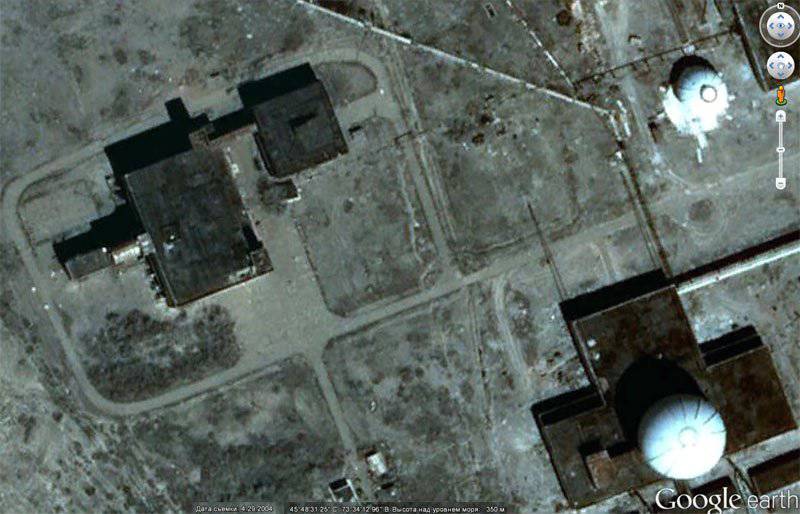
In the left part of the satellite image from 29.04.2004, the building of the 5Н26 complex with the LE-1 locator, at the bottom left of the Argun radar. 38-I site of the Sary-Shagan polygon
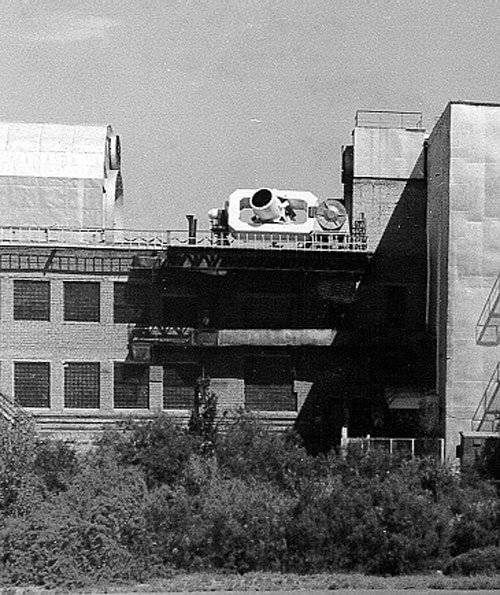
Telescope TG-1 laser locator LE-1, Sary-Shagan test site (Zarubin PV, Polskih SV From the history of the creation of high-energy lasers and laser systems in the USSR. Presentation. 2011 g.).
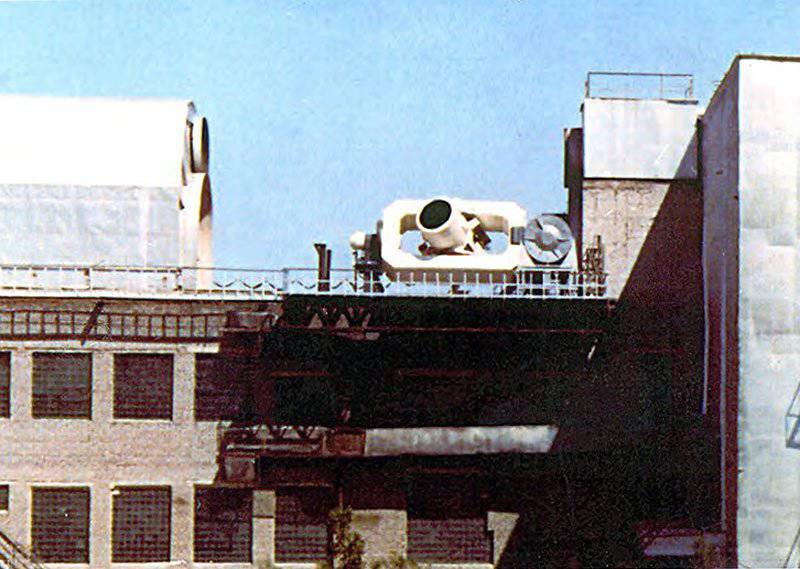
Telescope TG-1 laser locator LE-1, Sary-Shagan test site (Polskikh SD, Goncharova GV SSC RF FGUP NPO Astrophysics. Presentation. 2009 g.).
The study of photodissociation iodine lasers (VFDL) under the program "Terra-3".
The first laboratory photodissociation laser (FDL) was created in 1964, J.W. Casper and G.S.Pimentel. Because analysis showed that the creation of a super-power ruby laser pumped from a flash lamp was impossible, then in 1965, N.G. Basov and ON.Krokhin (both FIAN) proposed to develop a program for creating high-power PD-lasers based on the idea of using high-power optical radiation as a source of radiation and the energy of radiation of a shock front in xenon as a source. It was also assumed that the MS of the ballistic missile would be damaged due to the reactive effect of rapid evaporation under the influence of a laser of a part of the MS shell. Such PDLs are based on the physical idea formulated by X. Rautian and X. Sobelman in 1961, which showed theoretically that it is possible to produce excited atoms or molecules by photodissociation of more complex molecules when irradiated with a powerful (non-laser) light flux. . Works on explosive FDL (VFDL) as part of the Terra-3 program were deployed in cooperation with FIAN (V.S. Zuev, VFDL theory), VNIIEF (G.A. Kirillov, experiments with VFDL), Luch Central Design Bureau with the participation of GOI, GIPH and other enterprises. In a short time, the path was traveled from small and medium-sized prototypes to a number of unique high-energy VFDL samples produced by industrial enterprises. A feature of this class of lasers was their disposability - the VFD laser exploded completely collapsing during operation.
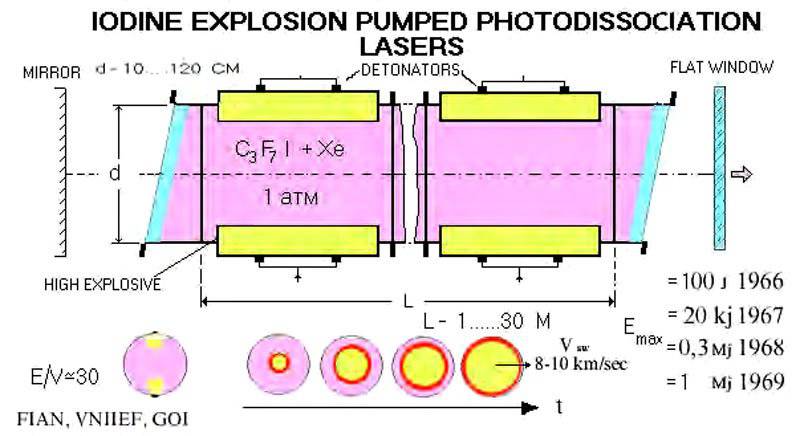
Schematic diagram of the work VFDL (Zarubin PV, Polskikh SV From the history of the creation of high-energy lasers and laser systems in the USSR. Presentation. 2011 g.).
The first experiments with FDL carried out in 1965-1967, gave very encouraging results and by the end of 1969 in VNIIEF (Sarov) under the direction of S. Kormer with the participation of scientists of FIAN and GOI were developed, assembled and PDLs with a pulse energy of hundreds of thousands of joules were tested, which was about 100 times higher than that of any laser known in those years. Of course, the creation of iodine PDLs with extremely high energies was not immediately possible. Tested various versions of the design schemes of lasers. A decisive step in the implementation of a workable design suitable for obtaining high radiation energies was accomplished in 1966, when, as a result of studying experimental data, it was shown that the proposal by scientists of FIAN and VNIIEF (1965) to remove the quartz wall separating the source of pump radiation and active environment can be implemented. The overall design of the laser has become much simpler and reduced to a shell in the form of a tube, inside which there is an elongated explosive charge inside or on the outer wall, and at the ends - mirrors of the optical resonator. Such an approach made it possible to design and test lasers with a working cavity diameter of more than a meter and a length of tens of meters. These lasers were assembled from standard sections of length about 3 m.
Somewhat later (with 1967), research and design of explosive-pumped FDL was successfully undertaken by the Vympel design bureau formed, and then the group of gas dynamics and lazerschik workers headed by V. Orlov, who transferred to the Luch Central Design Bureau. During the work, dozens of questions were considered: from the physics of the propagation of shock and light waves in a laser medium to the technology and compatibility of materials and the creation of special tools and methods for measuring the parameters of high-power laser radiation. Separately, there were questions of the explosion technique: the laser operation required obtaining an extremely “smooth” and straight-line front of a shock wave. This problem was solved, the charges were designed and methods for their detonation were developed, which made it possible to obtain the desired smooth front of the shock wave. The creation of these VFDL allowed us to begin experiments to study the effects of high-intensity laser radiation on materials and target designs. The work of the measuring complex was provided by GOI (I. Belousov).
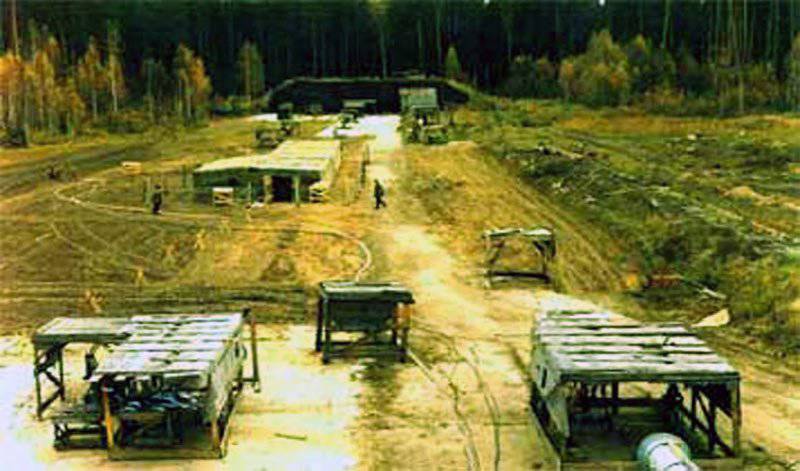
Test site for VFD lasers of VNIIEF (PV Zarubin, SV Polskikh. From the history of the creation of high-energy lasers and laser systems in the USSR. Presentation. 2011).
Development of models for VFDL TsKB Luch under the direction of V.K. Orlov (with the participation of VNIIEF):
- FO-32 - in 1967, with explosive pumped VFDL, the energy in a pulse was 20 KJ, the industrial release of VFDL FO-32 was launched in 1973;
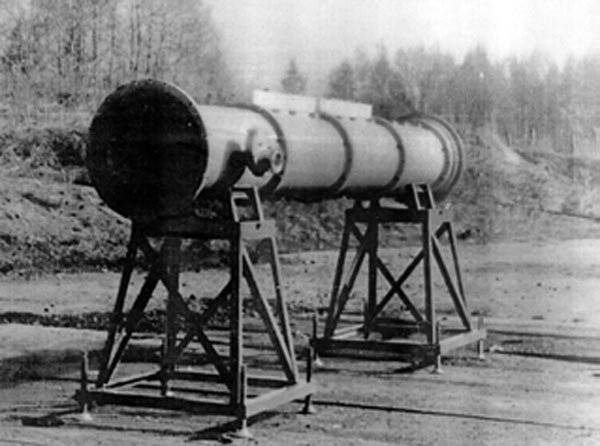
VFD laser FO-32 (Zarubin PV, Polskih SV From the history of the creation of high-energy lasers and laser systems in the USSR. Presentation. 2011 g.).
- FD-21 - for the first time in 1968, explosive pumped VFDL received energy in a pulse 300 KJ and also commercial production of VFD FD-1973 started in 21;
- F-1200 - in 1969 for the first time with explosive pumped VFDL, the energy in a pulse 1 was received megajoule. By 1971, the design was tested and in 1973, the industrial production of VFDL F-1200 was started;
Probably the F-1200 VFD laser prototype is the first mega-joule laser, assembled at VNIIEF, 1969 (Zarubin PV, Polskikh SV From the history of the creation of high-energy lasers and laser systems in the USSR. Presentation. 2011) .
The same VFDL, the same place and time. Measurements indicate that this is a different frame.
TTH VFDL:

The study of lasers using Raman scattering (WRC) program "Terra-3":
The dispersion of the radiation of the first VFDL was unsatisfactory — two orders of magnitude higher than the diffraction limit, which prevented the delivery of energy over considerable distances. In 1966, Mr. N. G. Basov and I. Sobelman and co-workers proposed to solve the problem by using a two-stage scheme — a two-stage combiner-scattering laser (SRS laser) pumped by several VFDL lasers with “bad” scattering. The high efficiency of the Raman laser and the high uniformity of its active medium (liquefied gases) made it possible to create a highly efficient 2 cascade laser system. The research of the WRC lasers was carried out by EM Zemskov (CDB "Luch"). After researching the physics of WRC lasers at FIAN and VNIIEF, the “team” of the Central Design Office “Luch” in 1974-1975. successfully conducted a series of experiments at the Sary-Shagan test site in Kazakhstan with the 2 cascade system of the AF series (FIAN, Luch - later Astrophysics). It was necessary to use large-size optics from specially developed fused quartz to ensure the radiation strength of the output mirror of the SRS laser. A multi-mirror raster system was used to introduce VFDL lasers into a Raman laser.
The power of the AJ-4T SRS laser reached 10 kJ in a pulse, and the 1975 tested an AJ-5T liquid oxygen laser with a pulse power already 90 kJ, an 400 mm aperture and 70% efficiency. Laser AJ-7T to 1975 was supposed to be used in the complex "Terra-3".
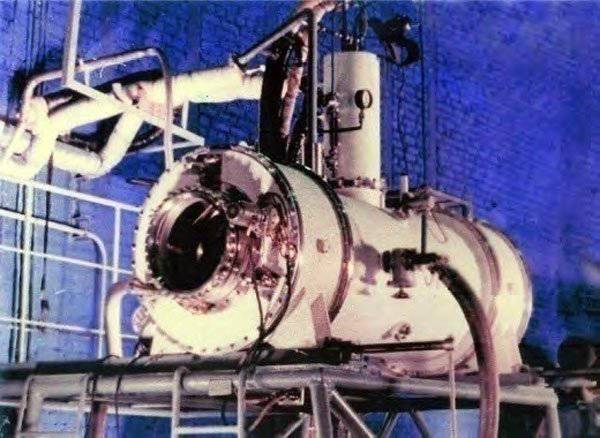
A liquid-Raman laser with an AJ-5T, 1975 g laser. A laser outlet is visible ahead. (Zarubin P.V., Polskikh S.V. From the history of the creation of high-energy lasers and laser systems in the USSR. Presentation. 2011).
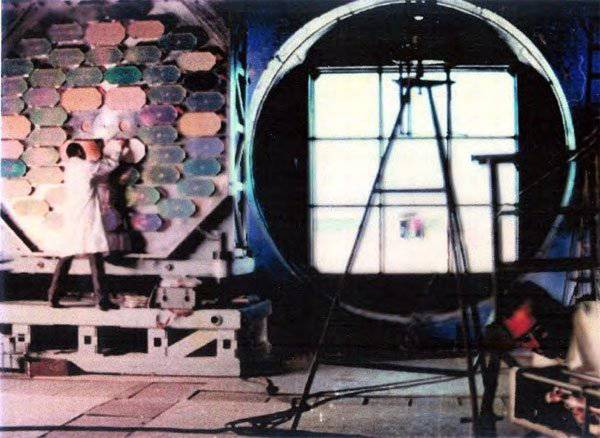
Multi-mirror raster system used to input VDFL radiation into an SRS laser (Zarubin PV, Polskikh SV From the history of the creation of high-energy lasers and laser systems in the USSR. Presentation. 2011).
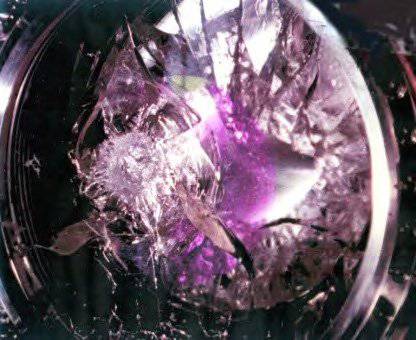
Glass optics destroyed by radiation from a Raman laser. Replaced with high-purity quartz optics (Zarubin PV, Polskikh SV From the history of the creation of high-energy lasers and laser systems in the USSR. Presentation. 2011).
Investigation of the effects of laser radiation on materials under the Terra-3 program:
An extensive program was carried out to study the effects of high-energy lasers on a variety of objects. Steel samples, various optics samples, and various applied objects were used as "targets." As a whole, the direction of immediation of impact on objects was headed by B.V. Zamyshlyaev, the direction of research on the radiation strength of optics was headed by A.M.Bonch-Bruevich. Work on the program was conducted from 1968 to 1976 years.
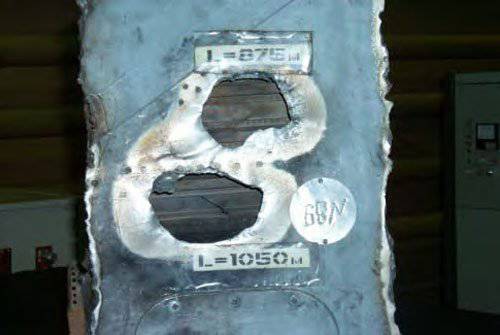
Influence of VEL radiation on a cladding element (Zarubin PV, Polskikh SV From the history of the creation of high-energy lasers and laser systems in the USSR. Presentation. 2011, city).
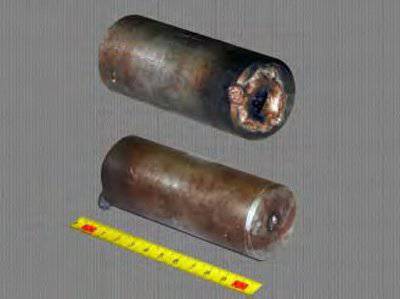
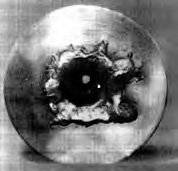
Steel sample thickness 15, see. The impact of solid-state laser. (Zarubin P.V., Polskikh S.V. From the history of the creation of high-energy lasers and laser systems in the USSR. Presentation. 2011).
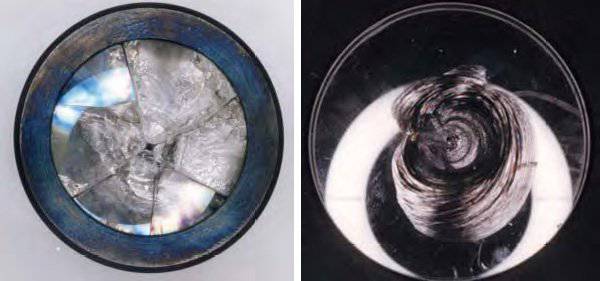
The impact of VEL radiation on optics (Zarubin PV, Polskikh SV From the history of the creation of high-energy lasers and laser systems in the USSR. Presentation. 2011).

Effect of a high-energy CO2 laser on an airplane model, NPO Almaz, 1976 (Zarubin PV, Polskikh SV From the history of the creation of high-energy lasers and laser systems in the USSR. Presentation. 2011).
Research of high-energy electric-discharge lasers using the Terra-3 program:
Reusable electrical discharge PDLs required a very powerful and compact pulsed source of electrical current. As such a source, it was decided to use explosive magnetic generators, the development of which was carried out by VNIIEF by a team led by A. I. Pavlovsky for other purposes. It should be noted that AD Sakharov also stood at the origins of these works. Explosive magnetic generators (otherwise they are called magnetically cumulative generators) as well as ordinary PD lasers are destroyed during operation when their charge explodes, but their cost is many times lower than the cost of a laser. Designed specifically for electric-discharge photodissociation chemical lasers by AI Pavlovsky and their colleagues, explosive magnetic generators contributed to the creation of an experimental laser in 1974 with a pulse energy of about 90 kJ. Tests of this laser are completed in 1975.
In 1975, a group of designers at the Luch Central Design Bureau, headed by V.K. Orlov, proposed to abandon explosive VFD lasers with a two-stage scheme (SRS) and replace them with electric-discharge PD lasers. This required further refinement and adjustment of the project complex. It was supposed to use a FO-13 laser with an 1 mJ pulse energy.
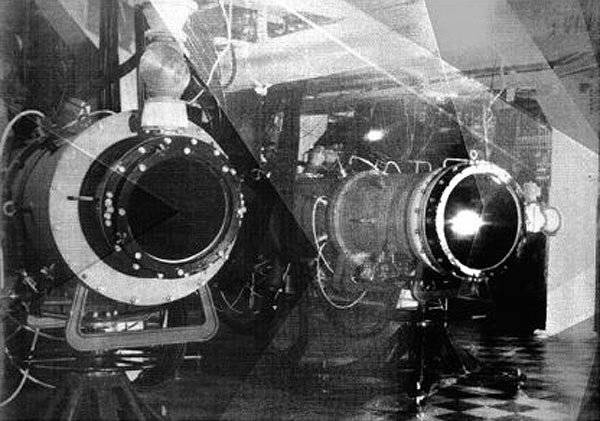
Large electric discharge lasers on VNIIEF assembly.
The study of high-energy electroionization lasers program "Terra-3":
The work on the 3D01 megawatt-type pulse-laser laser with an electron beam was started at the Central Design Bureau "Beam" on the initiative and with the participation of N.G. Basov and later separated into a separate direction in the OKB "Raduga" (later - GNIILTS "Raduga") under the direction of GG Dolgov-Savelyev. In experimental work in 1976, an electron-beam CO2 laser achieved an average power of about 500 kW at a repetition rate of up to 200 Hz. A scheme with a “closed” gas-dynamic contour was used. Later, an improved pulse-frequency laser KS-10 (TsKB Astrophysics, N.V. Cheburkin) was created.
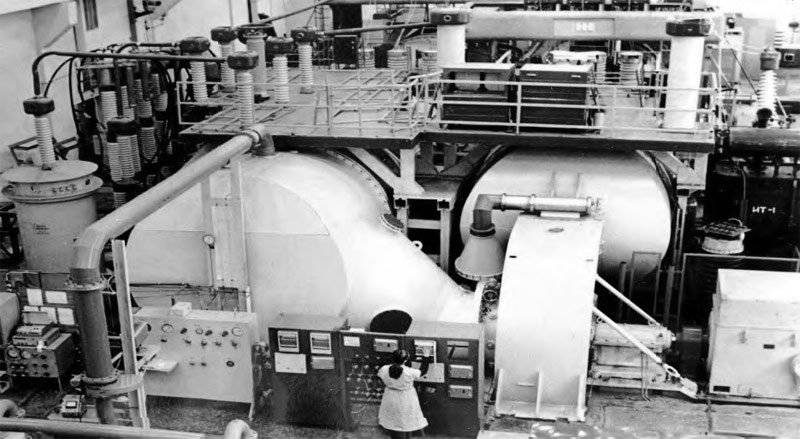
Frequency pulse electroionization laser 3D01. (Zarubin P.V., Polskikh S.V. From the history of the creation of high-energy lasers and laser systems in the USSR. Presentation. 2011).
Scientific-experimental shooting complex 5H76 "Terra-3":
In 1966, the OKB Vympel, under the direction of OA Ushakov, has begun the development of a draft project for the Terra-3 experimental complex. Work on the draft design continued on 1969. The military equipment engineer N.N.Shakhonsky was the direct supervisor for the development of structures. The placement of the complex was planned at the missile defense ground in Sary-Shagan. The complex was designed to conduct experiments on the destruction of ballistic warheads with high-energy lasers. The design of the complex was repeatedly adjusted in the period from 1966 to 1975. Since 1969, the design of the Terra-3 complex was conducted by the Luch central design office under the direction of MG Vasin. The creation of the complex was assumed using a two-stage Raman laser with the main laser at a considerable distance (about 1 km) from the guidance system. This was determined by the fact that it was supposed to use up to 30 tons of explosives in VFD lasers with radiation, which could have an impact on the accuracy of the guidance system. It was also necessary to ensure the absence of mechanical impact of VFD-laser fragments. The radiation from the Raman laser to the guidance system was supposed to be transmitted through an underground optical channel. It was assumed the use of laser AJ-7T.
In 1969, at the State Research Institute for Nuclear Research No. 10 of the USSR Ministry of Defense (military unit 03080, Sary-Shagan PRO landfill) at site No. XXUMX (military unit 38) began construction of facilities for experimental work on laser topics. In 06544, the construction of the complex was temporarily suspended for technical reasons, but in 1971, probably after updating the project, it was resumed.
The technical reasons (according to the source - Zarubin P.V. “Akademik Basov ...”) were that it was almost impossible to focus the beam on a relatively small area with a micron wavelength of laser radiation. Those. if the target is at a distance greater than 100 km, then the natural angular divergence of optical laser radiation in the atmosphere as a result of scattering is in 0,0001 degrees. It was installed in a specially designed to ensure the execution of the program to create a laser weapons The Institute of Atmospheric Optics at the Siberian Branch of the Academy of Sciences of the USSR in the city of Tomsk, which was headed by Acad. V.E.Zuev. It followed that the laser spot at a distance of 100 km will have a diameter of at least 20 meters, and the energy density over an area of 1 sq. Cm with the total energy of the laser source at 1 MJ will be less than 0,1 J / sq. Cm. This is too little - in order to hit a rocket (to create a hole in it in 1 sq. Cm, unsealing it), more 1 kJ / sq. Cm is required. And if initially it was supposed to use VFD lasers on the complex, then after determining the problem with focusing the beam, the developers began to lean toward using two-stage "adder" lasers on Raman scattering.
The design of the guidance system was carried out by GOI (P.P. Zakharov) together with LOMO (R.M. Kashirininov, B.Ya.Gutnikov). High-precision turntable was created at the factory "Bolshevik". High-precision drives and backlash-free gearboxes for support-turning devices were developed by the Central Research Institute of Automation and Hydraulics with the participation of the Moscow Technical University na Bauman. The main optical path was completely made on the mirrors and did not contain transparent optical elements that could be destroyed by radiation.
In 1975, a group of designers at the Luch Central Design Bureau, headed by V.K. Orlov, proposed to abandon explosive VFD lasers with a two-stage scheme (SRS) and replace them with electric-discharge PD lasers. This required further refinement and adjustment of the project complex. It was supposed to use a FO-13 laser with an 1 mJ pulse energy. Ultimately, facilities with combat lasers were never completed and put into operation. Only the complex guidance system was built and used.
Academician of the USSR Academy of Sciences B.V. Bunkin (Almaz Scientific and Production Association) was appointed the General Designer of the experimental work at the 2506 facility (the Omega complex of anti-aircraft defense armament equipment - KSV PSO), at the 2505 facility (the Anti-CWD PRO and PKO Terra -3 ") - Corresponding Member of the USSR Academy of Sciences N.DUstinov (" TsKB "Luch"). Scientific supervisor of works - Vice-President of the USSR Academy of Sciences Academician E.P. Velikhov. From the 03080 military unit analysis of the functioning of the first laser prototypes PSN and ABM facilities were supervised by the Chief of the 4 Division of the 1 Division, Lieutenant Colonel G.I. Semenikhin. From 4 GUMO with 1976 the role of development and testing of weapons and military equipment on new physical principles using lasers was carried out by the head of the department who became the laureates of the Lenin Prize for this cycle of works in 1980, Colonel Y. Rubanenko. At the "2505" object ("Terra-3") construction was going on, first of all, at the control and firing position (CPC) 5Ж16K and in zones “G” and “D.” Already in November 1973, the first experimental combat work was conducted at the CPC. In 1974, to summarize the work on the creation of weapons based on new physical principles, an exhibition was organized at the test site in “Zone G” with a demonstration of the newest tools developed by the entire USSR industry in this field. The exhibition was visited by the USSR Minister of Defense Marshal A.A. Grechko. The combat work was carried out using a special generator. The battle crew was led by Lieutenant Colonel I.V. Nikulin. For the first time, a target about the size of a five-kopeck coin at a short distance was hit by a laser at the test site.
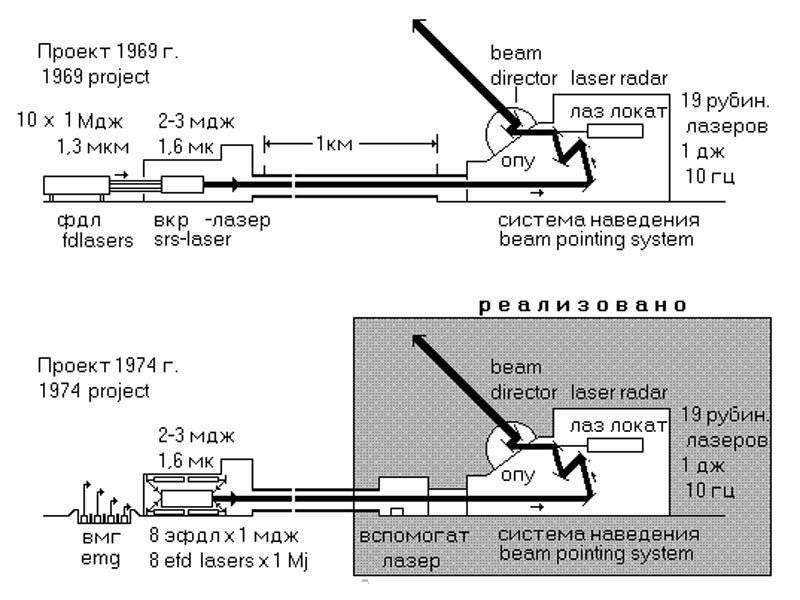
The initial project of the complex "Terra-3" 1969, the final project of 1974, and the volume of realized components of the complex. (Zarubin P.V., Polskikh S.V. From the history of the creation of high-energy lasers and laser systems in the USSR. Presentation. 2011).
The achieved success has accelerated the work on the creation of the experimental laser complex 5H76 "Terra-3". The complex consisted of the 41 / 42В construction (the southern building, sometimes called the "41 platform") in which the command and computing point was located on the basis of three M-600 calculators, the exact 5H27 laser locator - an analogue of the LE-1 / 5NXXXXXXXUM laser locator see above), data transmission system, single time system, system of special technical equipment, communications, alarm systems. The test work at this facility was carried out by the 26 department of the 5 test complex (head of the department Colonel I.V. Nikulin). However, at the 3Н5 complex, the bottleneck was the lag in the development of a powerful special generator for implementing the technical characteristics of the complex. It was decided to install an experimental generator module (simulator with a CO76 laser?) With the achieved characteristics for testing the combat algorithm. It was necessary not far from the 2 / 41В structure to build the 42А structure for this module (the south-north building, sometimes called "Terra-6"). The problem of the special generator has not been resolved. The structure for the combat laser was erected north of the "2 site", a tunnel with communications and a data transmission system led to it, but the installation of the combat laser was not carried out.
The experimental polygon laser setup consisted of the actual lasers (a ruby - an array of 19 ruby lasers and a CO2 laser), a beam guidance and beam retention system, an information system designed to ensure the functioning of the guidance system, as well as a high-precision 5H27 laser locator, designed to accurately determine the coordinates goals The capabilities of 5Н27 made it possible not only to determine the distance to the target, but also to obtain exact characteristics based on its trajectory, the shape of the object, its dimensions (non-coordinate information). With the help of 5Н27, space objects were monitored. The complex was tested on the effects of radiation on the target, pointing the laser beam at the target. With the help of the complex, studies were performed on aiming the beam of a low-power laser on aerodynamic targets and on studying the processes of propagation of a laser beam in the atmosphere.
Testing of the guidance system began in 1976-1977, but the work on the main firing lasers did not come out of the design stage, and after a series of meetings with the Minister of Defense Industry of the USSR S.A. Zverev, it was decided to close the Terra 3 ". In 1978, with the consent of the USSR Ministry of Defense, the program for creating the 5H76 complex "Terra-3" was officially closed.
The installation was not commissioned and did not work in full, did not solve combat tasks. The construction of the complex was not fully completed - the guidance system was installed in full, the auxiliary lasers of the guidance system locator and the power beam simulator were mounted. By 1989, work on the laser theme began to curl. In 1989, at the initiative of Velikhov, the Terra-3 installation was shown to a group of American scientists.
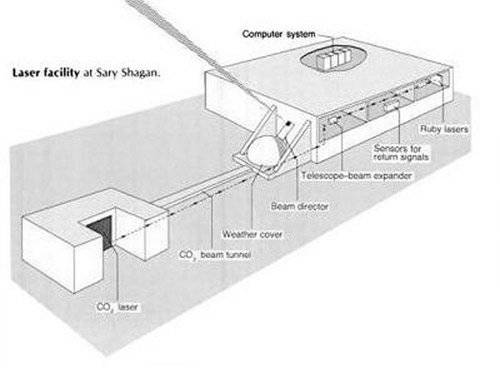
Scheme of construction 41 / 42В complex 5Н76 "Terra-3".
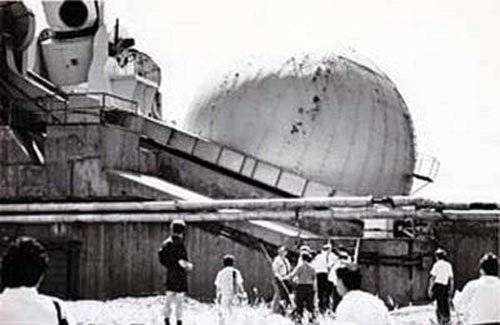
The main part of the 41 / 42 facility in the 5H76 complex "Terra-3" is a telescope of the guidance system and a protective dome, the picture was taken during a visit to the object of the American delegation, 1989.
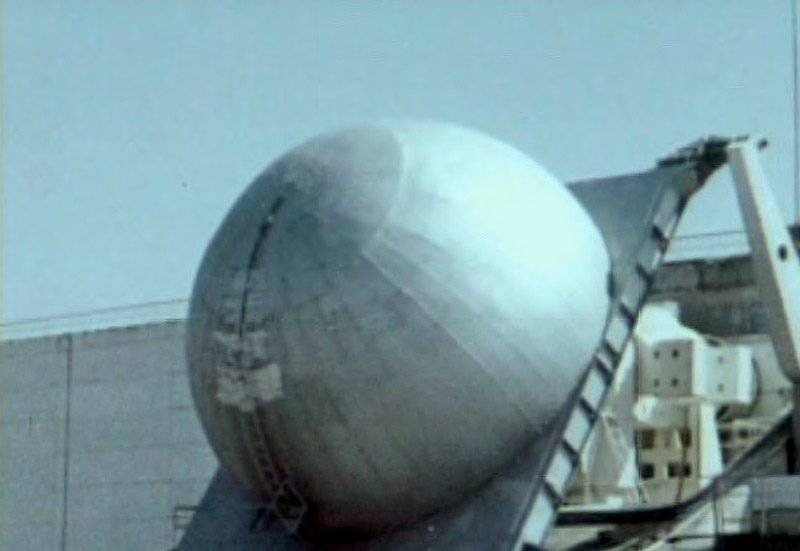
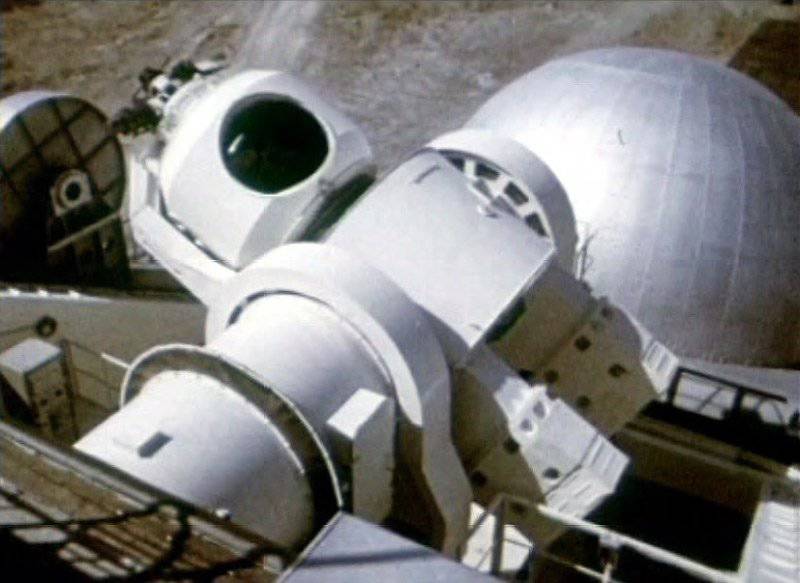
The guidance system of the Terra-3 complex with a laser locator (Zarubin PV, Polskikh SV From the history of the creation of high-energy lasers and laser systems in the USSR. Presentation. 2011).
Title: the USSR
- 1964 G. - N.G. Basov and O.N.Krokhin formulated the idea of defeating the GS BR with a laser.
- 1965, autumn - a letter to the Central Committee of the CPSU about the need for an experimental study of laser missile defense.
- 1966 g. - the beginning of work on the program "Terra-3".
- 1984 d. 10 October - laser locator 5Н26 / ЛЭ-1 carried out measurements of the parameters of the target - the space shuttle "Challenger" (USA). In the autumn of 1983, Marshal of the Soviet Union, D. F. Ustinov, suggested that the commander of the ABM and PKO troops, Yu.Votintsev, use a laser complex to accompany the shuttle. At that time, a team of 300 specialists carried out modifications at the complex. This was reported to Y. Votintsev to the Minister of Defense. October 10 1984 during the 13 flight of the Challenger shuttle (USA), when its orbits took place in the area of the Sary-Shagan test site, the experiment took place during the operation of the laser facility in the detection mode with the minimum radiation power. The height of the orbit of the ship at that time was 365 km, the slant detection and tracking range - 400-800 km. Accurate target designation of the laser machine was issued by the Argun radar complex.
As the crew of the Challenger reported later, during the flight over the Balkhash region, the ship suddenly disconnected communication, there were malfunctions in the equipment, and the astronauts themselves felt unwell. Americans began to understand. Soon they realized that the crew had been subjected to some kind of artificial influence from the USSR, and declared an official protest. Based on humane considerations, the laser installation, and a part of the radio-technical complexes of the landfill, which have a high energy potential, were not used to accompany the Shuttles. In August, the 1989 of the year, part of the laser system, designed to aim the laser at the object, was shown to the American delegation.
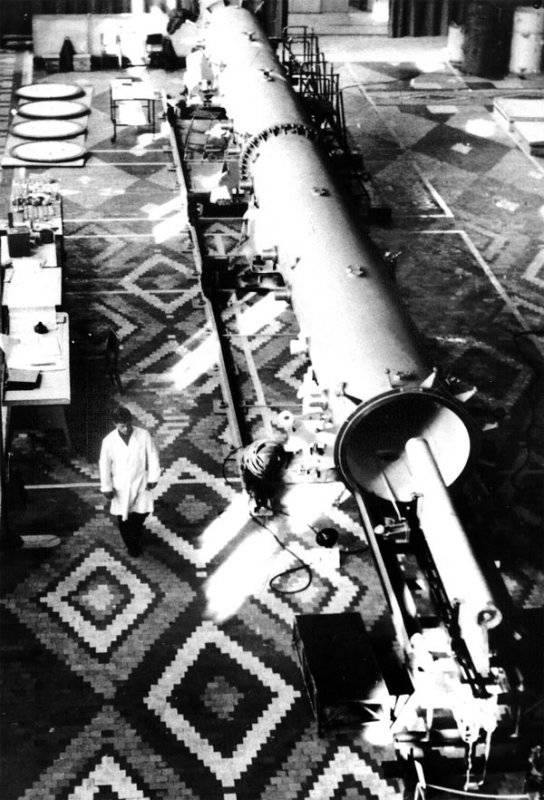
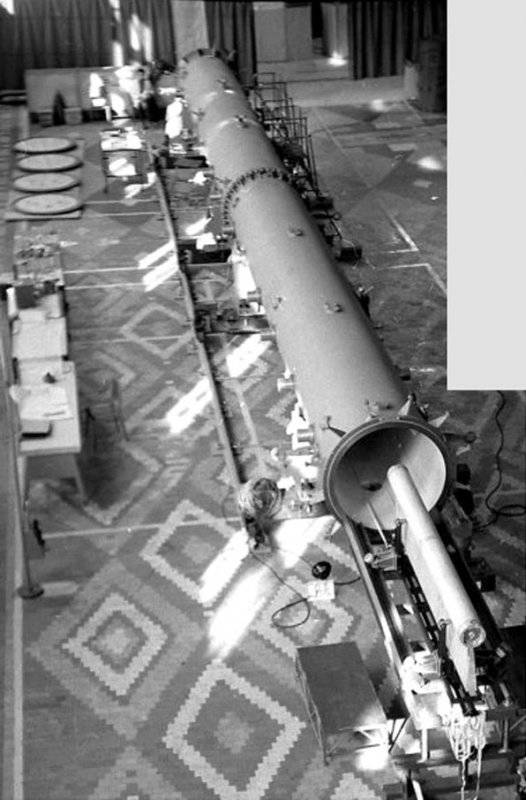
Information